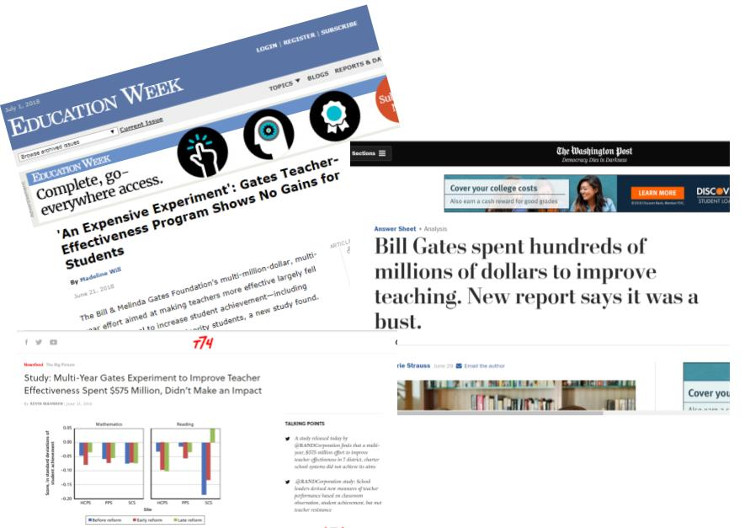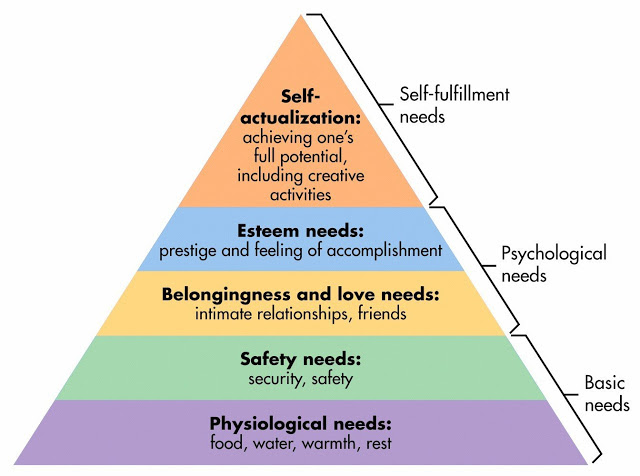Gates & Teacher Effectiveness: Duh
If you're an innovative educator, the news about teacher effectiveness having little impact on student achievement is no surprise. The Gates Foundation spent a whooping $575 million buckaroos, when they could have just been listening to teachers who knew better.

The work that is necessary to support student learning is easy to understand and hard to implement. It begins with Maslow's seminal work on human motivation. Any good teacher knows his hierarchy by heart.
[The Key to Differentiated Learning - Develop Student Experts]

Gates mistake was moving directly to the top of the pyramid. The foundation neglected to acknowledge that we are teaching so many children whose basic needs are not being met. First, we must address that. It is unacceptable that in districts like the one I work there are staggering numbers of homeless children. In every city, but especially one of the wealthiest in the nation, it is unacceptable that having a home is not a right. There are large numbers of children that are being raised without a father. The men need to step up. There are also many children not being raised by their mother or father. Hundreds of thousands of children bounce from home to home to group home to residential treatment center in foster care. Of course, children who live with their parents may be suffering from abuse or simply the high level of anxiety school pressure puts on many students today.
Help comes in the way of providing the basics for our students: Stable homes. Safe and security. Food. Climate control (i.e. heat and air conditioning). Time for naps if necessary.
It means revamping teacher preparation and professional development to include: Supporting children living in trauma. Guidance counseling. Psychotherapy.
But it doesn't end there.
Tools and ideas to transform education. Sign up below.
Even after we do all the work it takes to provide the basics for our children, many schools still don't have it right. What's next is belongingness and love. Devoid of that we will continue to see kids in gangs and victims being murdered.
There are several school models i.e. Agile, Big Picture, or Democratic Schools that know how to achieve this and the answer is simple!
Smaller student to teacher ratio. Period.
And, it's not just class size, but also class load. Research tells us that no teacher should ever have to teach more than five different classes. If they do, it is impossible for them to help students develop that relationship or belongingness.
Our students and colleagues should be our family. In Big Picture Schools they outline the keys to student success. Small size, intimate advisory system, and insistence on parent participation all lead to making the school feel like a family and several features extend these connections and family feel even after graduation.
Lisa Nielsen writes for and speaks to audiences across the globe about learning innovatively and is frequently covered by local and national media for her views on “Passion (not data) Driven Learning,” "Thinking Outside the Ban" to harness the power of technology for learning, and using the power of social media to provide a voice to educators and students. Ms. Nielsen has worked for more than a decade in various capacities to support learning in real and innovative ways that will prepare students for success. In addition to her award-winning blog, The Innovative Educator, Ms. Nielsen’s writing is featured in places such as Huffington Post, Tech & Learning, ISTE Connects, ASCD Wholechild, MindShift, Leading & Learning, The Unplugged Mom, and is the author the book Teaching Generation Text.
Lisa Nielsen (@InnovativeEdu) has worked as a public-school educator and administrator since 1997. She is a prolific writer best known for her award-winning blog, The Innovative Educator. Nielsen is the author of several books and her writing has been featured in media outlets such as The New York Times, The Wall Street Journal, and Tech & Learning.
Disclaimer: The information shared here is strictly that of the author and does not reflect the opinions or endorsement of her employer.
